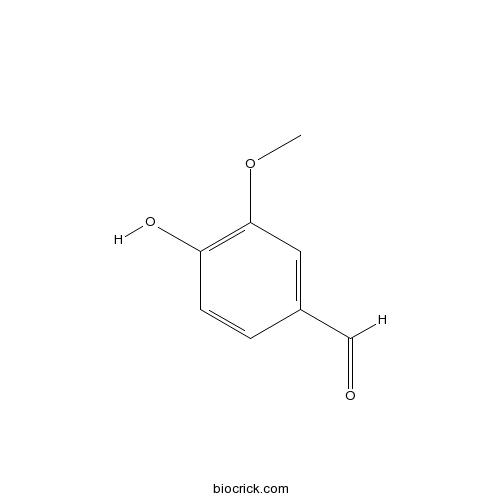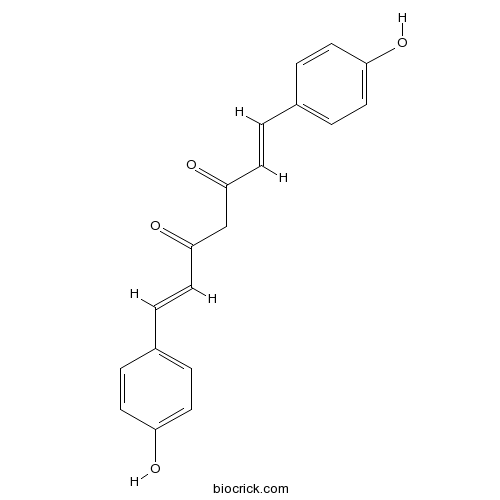Curcuma longa
Curcuma longa
1. The products in our compound library are selected from thousands of unique natural products; 2. It has the characteristics of diverse structure, diverse sources and wide coverage of activities; 3. Provide information on the activity of products from major journals, patents and research reports around the world, providing theoretical direction and research basis for further research and screening; 4. Free combination according to the type, source, target and disease of natural product; 5. The compound powder is placed in a covered tube and then discharged into a 10 x 10 cryostat; 6. Transport in ice pack or dry ice pack. Please store it at -20 °C as soon as possible after receiving the product, and use it as soon as possible after opening.

Natural products/compounds from Curcuma longa
- Cat.No. Product Name CAS Number COA
-
BCN2605
Vanillin121-33-5
Instructions

-
BCN5974
Demethoxycurcumin22608-11-3
Instructions

-
BCN5975
Bisdemethoxycurcumin33171-05-0
Instructions

-
BCN5504
Curcumin458-37-7
Instructions

-
BCN2748
Dimethylcurcumin52328-98-0
Instructions

-
BCN4981
Germacrone6902-91-6
Instructions

-
BCN1265
Alismoxide87701-68-6
Instructions

Potent Antitumor Effects of a Combination of Three Nutraceutical Compounds.[Pubmed: 30111862]
Head and neck squamous cell carcinoma (HNSCC) is associated with low survival, and the current aggressive therapies result in high morbidity. Nutraceuticals are dietary compounds with few side effects. However, limited antitumor efficacy has restricted their application for cancer therapy. Here, we examine combining nutraceuticals, establishing a combination therapy that is more potent than any singular component, and delineate the mechanism of action. Three formulations were tested: GZ17-S (combined plant extracts from Arum palaestinum, Peganum harmala and Curcuma longa); GZ17-05.00 (16 synthetic components of GZ17-S); and GZ17-6.02 (3 synthetic components of GZ17S; curcumin, harmine and isovanillin). We tested the formulations on HNSCC proliferation, migration, invasion, angiogenesis, macrophage viability and infiltration into the tumor and tumor apoptosis. GZ17-6.02, the most effective formulation, significantly reduced in vitro assessments of HNSCC progression. When combined with cisplatin, GZ17-6.02 enhanced anti-proliferative effects. Molecular signaling cascades inhibited by GZ17-6.02 include EGFR, ERK1/2, and AKT, and molecular docking analyses demonstrate GZ17-6.02 components bind at distinct binding sites. GZ17-6.02 significantly inhibited growth of HNSCC cell line, patient-derived xenografts, and murine syngeneic tumors in vivo (P < 0.001). We demonstrate GZ17-6.02 as a highly effective plant extract combination and pave the way for future clinical application in HNSCC.
Oral administration of powdered dried rhizomes of Curcuma longa L. (turmeric, Zingiberaceae) is effective in the treatment of doxorubicin-induced kidney injury in rats.[Pubmed: 30109739]
None
Femtosecond laser pulse assisted photoporation for drug delivery in Chronic myelogenous leukemia cells.[Pubmed: 30098520]
Chronic myelogenous leukemia (CML) is a myeloproliferative disorder occurs in the pluripotent hematopoietic stem cell. Currently, first-generation tyrosine kinase inhibitor (TKI) imatinib is the mainstay for the treatment of CML. Second generation TKI's like ponatinib, dasatinib, nilotinib, and bafetinib were treated against resistant CML. However, several CML patients develop resistance towards all existing inhibitors. Curcumin (Curcuma longa) a plant-derived natural compound is an effective bioactive component against various cancers including CML. Many studies have shown that curcumin induces time- and dose-dependent apoptosis in CML cells by regulating various downstream molecular regulators. Despite curcumin's selective cytotoxicity towards cancer cells, it has very poor bioavailability both in in-vitro and in-vivo conditions. In this present study, we have used femtosecond laser (fs-laser) pulses to ablate the cell membrane and standardized the conditions required for creating a cell membrane pores with less lethality. Following fs-laser pulse irradiation, K562 cells were incubated along with curcumin 30 μM for 0 h, 6 h,12 h and 24 h. Interestingly irradiated cells have shown higher sensitivity towards curcumin than non-irradiated cells. Immunoblotting studies showed higher induction levels of cleaved caspase 3 and 9 in irradiated population than non-irradiated. In summary, the results prove that irradiation by fs-laser pulses enhanced the bioavailability of curcumin and shows caspase-mediated cell death in irradiated CML cells than other populations.
The regulatory role of curcumin on platelet functions.[Pubmed: 30098070]
Curcumin, the main ingredient of Curcuma longa L., has been used as a spice and as a herbal medicine with different therapeutic characteristics for centuries in Asian countries. This phytochemical has been shown to possess beneficial antiplatelet activity that has introduced it as a promising candidate for the treatment of thromboembolism, atherothrombosis, and inflammatory diseases. Platelet dysfunction under different circumstances may lead to cardiovascular disease, and curcumin has been shown to have beneficial effects on platelet dysfunction in several studies. Therefore, this narrative review is aimed to summarize available evidence on the antiplatelet activity of curcumin and related molecular mechanisms for this activity.
Curcumin/Turmeric as an Environment-Friendly Protein Gel Stain.[Pubmed: 30097937]
Curcumin, the main curcuminoid in food spice turmeric, is insoluble in water at room temperature. We showed that curcumin can be solubilized in water with the application of heat (100 °C). Here we demonstrate that heat-solubilized curcumin can serve as a nontoxic and environment-friendly fluorescent/colorimetric reversible protein stain. Curcumin, the yellow pigment found in the rhizomes of the perennial herb Curcuma longa (turmeric), is insoluble in aqueous solvents. However, heat solubilization in water renders 1.5% of curcumin soluble. Curcumin solubilized by ethanol or alkali is ineffective in staining proteins. Heat-solubilized curry spice turmeric also stains proteins. Staining is achieved in 30 min, with a sensitivity almost equaling that of Coomassie Brilliant Blue (CBB). Destaining is not required and excess curcumin/turmeric can be discarded into the sink. Binding of proteins by silver inhibits curcumin binding, suggesting similarity of protein binding by silver and curcumin. It costs $1.5-2.0 to stain a mini-gel with curcumin, while turmeric costs less than 0.005 cent. CBB staining/destaining costs about two cents. Curcumin/turmeric, thus, can serve as an ideal nontoxic protein stain.


